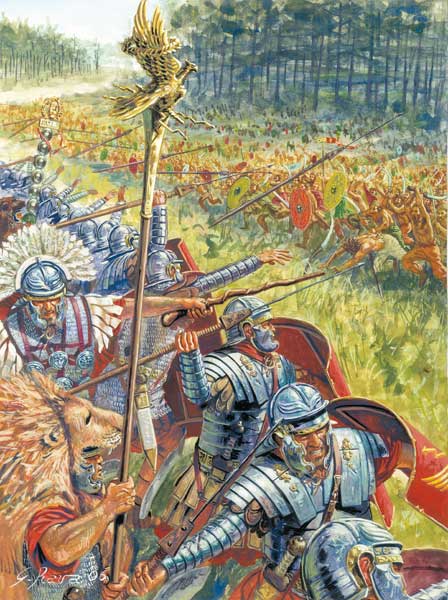I am pretty sure I saw it in a German source too, but I could be mistaken. My guess is it is between 1175-1225. If I find more on it I will update of course, but don't hold your breath 
- Home
- Forums
- Miscellaneous
- The Anachronist's Guild - Off-Topic Chat
- The Sage's Guild - Historical Discussion
You are using an out of date browser. It may not display this or other websites correctly.
You should upgrade or use an alternative browser.
You should upgrade or use an alternative browser.
Best-dressed Warrior
- Thread starter Chilly5
- Start date
Users who are viewing this thread
Total: 3 (members: 0, guests: 3)
Roach XI the Magnificent
Squire

FrisianDude
Archduke

Segmenta vambraces?
Also, I think I've seen that odd pot-helmet differently.
Also, I think I've seen that odd pot-helmet differently.
It's called a Manica. Surely you know this.FrisianDude said:Segmenta vambraces?
Also, I think I've seen that odd pot-helmet differently.
That helm shares a few similarities with others I've seen.
It simply looks like a development of the Norman faceplate helmets. Somewhere between the proper great-helm, and This:

Roach XI the Magnificent
Squire

FrisianDude said:Segmenta vambraces?
Also, I think I've seen that odd pot-helmet differently.
Yes. They had been around since the Persians made their empire, although the Romans were the first to use them on infantry,
Rallix, you are right that it looks like a development of that form, which is why I guessed it would be between 1175 (when those you showed were certainly around by) and 1225 (around when the true Great Helm was seen).
Blackthorn
Squire

That PRECISE helmet is from a single German instance from 1220. Give me time and I'll find a picture of the original. The lack of a 'higher back' gives away that it's not before 1200. 
FrisianDude
Archduke

I thought the manica was more like a single metal splint.Rallix said:It's called a Manica. Surely you know this.FrisianDude said:Segmenta vambraces?Simply laminar going down the arm.
Though that picture, as horrible as it is, is supposed to be April 1242...since it is called "Ice Battle" and is obviously referring to the Battle of Lake Peipus. That Teutonic is horribly represented for so many reasons...leg armor is post 1240's (actually it looks like 1300 armor) and his clothing has colors in it...which the friars of the order would not do. That one with the red helmet is probably supposed to be an Estonian Dane though.
Blackthorn
Squire

Ugh. In that case, frankly, they've played a fun game of "hunt through history" and shoved some godawful stuff together. Urghhhh.Skot the Sanguine said:Though that picture, as horrible as it is, is supposed to be April 1242...since it is called "Ice Battle" and is obviously referring to the Battle of Lake Peipus. That Teutonic is horribly represented for so many reasons...leg armor is post 1240's (actually it looks like 1300 armor) and his clothing has colors in it...which the friars of the order would not do. That one with the red helmet is probably supposed to be an Estonian Dane though.
JScott17
Veteran

Rallix said:It's called a Manica. Surely you know this.FrisianDude said:Segmenta vambraces?Simply laminar going down the arm.
Weren't those introduced because of some kind of weapon the Thracians, Dacians, and Illyrians used?
I think it was called a Rhomphaia or something.
Otherwise known as the falx.JScott17 said:Rallix said:It's called a Manica. Surely you know this.FrisianDude said:Segmenta vambraces?Simply laminar going down the arm.
Weren't those introduced because of some kind of weapon the Thracians, Dacians, and Illyrians used?
I think it was called a Rhomphaia or something.
Isn't a falx slightly more curved than a Rhomphaia?Rallix said:Otherwise known as the falx.JScott17 said:Rallix said:It's called a Manica. Surely you know this.FrisianDude said:Segmenta vambraces?Simply laminar going down the arm.
Weren't those introduced because of some kind of weapon the Thracians, Dacians, and Illyrians used?
I think it was called a Rhomphaia or something.
Roach XI the Magnificent
Squire

No. Rhomphaia is the Greek name for the falx.
Blackthorn
Squire

JScott17 said:Weren't those introduced because of some kind of weapon the Thracians, Dacians, and Illyrians used?
I think it was called a Rhomphaia or something.
Yeah- a lot of people overestimate the cutting power of single-handed swords, even the longer and heavier types. Romans used to suffer some limb injuries, but even a small amount of wound fabric or leather around the wrists prevented severe injury, and superficial cuts could be stitched quite effectively. The second two-handed bill like weapons enter the equation, the number of debilitating limb wounds means that you lose a LOT of combat-effective men very quickly; hence the sudden adoption of limb armour. Something similar can be seen again around the late Carolingian/Early Norman crossover- as larger axes and more polearms appear in Western Europe, mailleshirts rapidly expand to give full sleeve protection as a standard must-have. When the bill continues to develop the limb armour continues to improve rapidly; first boiled leather and steel splinting and poleyns, and then slowly fully enclosed plate segments.
And as a personal note- having been hit with fully blunt, lightweight bills, you gain a respect for the power of a big blade on a two-handed stick- cracked a shin or two in my time...
Uh so as you might all know Im quite a noob when it comes to telling the dates of armour, I want to change this so I have been Reading British and foreign arms and armour by Charles Ashdown, is this a good source? its like 100 years old now so there may be a few things I have to look out for, also any other reads I should go for?
Similar threads
- Replies
- 1
- Views
- 424
- Replies
- 157
- Views
- 29K














